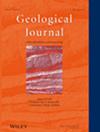Late Ordovician Bentonites From the Southern Ordos Basin: Response to the Subduction of the Proto-Tethys Ocean
Abstract
The connection between the Ordovician bentonites on the southern margin of the Ordos Basin and the Early Palaeozoic volcanic rocks of the North Qinling Orogenic Belt is crucial for understanding the subduction and collisional closure of the Shangdan Ocean during the Early Palaeozoic. This paper investigates zircon U–Pb ages, geochemistry and Lu–Hf isotopic compositions of zircons in the Upper Ordovician Zhaolaoyu Formation bentonites located on the southern margin of the Ordos Basin. U–Pb dating of zircon indicates a coeval age of 453.3 ± 1.4 Ma (MSWD = 0.99), which represents the crystallisation age during the Late Ordovician Katian stage. The bentonites exhibit higher SiO2 (57.94–77.95 wt.%) and Al2O3 (9.21–14.33 wt.%), classifying them within the low-potassium alkali basalt to medium-potassium calc-alkaline series. The parent rock of the bentonites is likely intermediate to felsic volcanic rocks. The rare earth element partitioning curves of the bentonites are right-dipping, with a more pronounced negative Eu anomaly (δEu = 0.48–0.67). The zircons in the bentonites yield two-stage model ages ranging from 546 to 956 Ma, along with ε Hf(t) values between 5.56 and 13.55. These results indicate that the bentonites are products of volcanic arc magma formed in a subduction–collision environment. The interbedded bentonites in the Upper Ordovician limestones of the southern margin of the Ordos Basin may be associated with the northward subduction of the Shangdan Oceanic crust, reflecting the subduction and consumption of the Proto-Tethys Ocean along the southern margin of the North China Block.


 求助内容:
求助内容: 应助结果提醒方式:
应助结果提醒方式:


